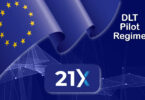Today many industries have one or more blockchain consortia tackling industry business problems. Few have the same urgency as the US pharmaceutical sector. The Drug Supply Chain Security Act (DSCSA) phases in through to 2023, with a deadline for returns in November 2019. The legislation requires drugs to be serialized and traceable.
Business case
Right now blockchain and drug quality are somewhat topical. China has suffered another scandal where vaccines given to babies were ineffective. The public is demanding a solution, and blockchain can play a part.
MediLedger aims to be the industry consortium to tackle serialization and other business problems.
The first one relates to saleable returns. The DSCSA legislation that comes into force next year addresses the returns issue. It requires all items to have a serial number so that when it’s returned, it can be verified as authentic. That’s because someone might return counterfeit drugs which are unwittingly re-sold by the manufacturer or wholesaler.
The volume of returns is massive, though it represents only 2-3% sales. A figure often used is $6 billion, but that’s conservative. This is probably based on US manufacturer sales which had a net value of $323 billion in 2016.
According to pharma intelligence group Evaluate, the 2018 forecast revenue for the top ten global pharmaceutical companies is $355 billion. Based on 2106 figures, the top ten companies represent half of the sales of the top fifty companies. So the global returns figure is more than $14 billion, and if returns are closer to three percent than it could be as high as $21 billion.
About MediLedger
MediLedger aims to be an open network addressing the entire pharma supply chain. The initial members were pharma manufacturers Genentech, Abbvie, and Pfizer. Plus they have two of the largest pharma wholesalers in McKesson and AmerisourceBergen. Abbvie has since been replaced by three top ten manufacturers who can’t be named quite yet. But that’s just the start. In the future, it will include dispensers and every aspect of the supply chain.
Susanne Somerville was previously VP of Supply Chain at Genentech/Roche, where she worked with Eric Garvin. In early 2016 they joined forces to do serialization consulting for companies and were quickly steered towards blockchain. They found a technology partner in San Fransisco-based Chronicled. With great success from that two-year relationship, earlier this year Somerville and Garvin joined the Chronicled executive team.
Why blockchain, why now?
The need to share information amongst numerous parties and have a single source of truth makes blockchain a good match for drug serialization. MediLedger’s blockchain stores data on several separate nodes or servers, which makes it hard for a counterfeiter to manipulate the data. If they manage to hack one server, they won’t be able to manipulate data across all the others.
In terms of why now, the looming November 2019 deadline for returns is driving some urgency. Somerville believes there’s also a recognition that the returns solution provides a good foundation for future DSCSA phases that involve full supply chain traceability.
Another motivation for innovation and efficiency is the ever-present specter of Amazon creeping into the mix.
Somerville added: “Companies are beginning to see now that blockchain isn’t going to go away. And so I think being part of the discussion of how governance should form for an industry-owned blockchain is of interest to people as well.”
Governance
The vision is to create a foundation that the industry will own and govern. The foundation will govern decisions like the terms and conditions of participation, and choices on policy decisions. But Somerville is keen to steer clear of politics.
When asked whether MediLedger could fit into an existing pharma industry group, the reason given for creating something new was the need to avoid bias towards one sub-group. Whether that is manufacturers, wholesalers or dispensers.
“We don’t want this governance to decide the industry business rules or interpretation of business rules. We literally want companies to come with the rules they want, and we just implement them in software and code,” said Somerville.
Inclusiveness is essential for creating industry standards. It’s crucial to bring companies together early, so there’s buy-in for the standards. It won’t work if a couple of companies come up with some rules that they expect everyone else to adopt without consultation.
But there are still some governance issues to iron out.
“We’ve had a lot of discussions internally about data. Once data is put on a blockchain, it’s owned by the network. It’s not owned by a company anymore. Really working through with the group a lot of the nuance of that, because it might be slightly different than how they’ve operated before.”
Another topic of discussion is some company’s concerns about being accountable for software that could stop shipments belonging to competitors.
Ecosystem
MediLedger is offering its solution and specifications to pharma service providers who can incorporate it into their products. Individual companies can use it as well.
SAP also has a pharma supply chain solution. Somerville thinks their approach is quite different and that the MediLedger and SAP solutions complement each other. She’s keen to involve SAP in the MediLedger network.
There’s also an appetite to open up the network to third-party developers in the future.
Snowball effect
The beauty of a well functioning consortium is you get to address shared pain points. For pharma companies, their back-office operations shouldn’t be strategic differentiators. So naturally other topics have popped up.
Somerville believes if you can establish a strong network and get one or two use cases working, then it becomes easier to add further solutions. Much like an app store.
One of them is the painful payment and refund process.
Payments
Any process that involves returns is always painful. With $6 billion a year of returns, that’s a significant amount of mess.
The pharma sales process is complex involving many parties and pieces of information. There’s a lot of emailing of data, which always results in human error and inefficiencies.
The pharma companies agree on prices and contract terms with the Group Purchasing Organizations (GPO) which negotiate on behalf of hospitals and nursing homes. But the membership of a GPO is continually changing. Even where there’s a central store of members, the parties are likely to extract the data at different times.
Plus there are many other sets of shifting data. Contract terms and prices only apply to particular time frames. And pharma companies provide master data about what’s in their drugs, which evolves.
A single source of truth on a blockchain would be helpful.
So there’s a good chance this will be the next thing to address after the DCSCA returns solution goes live.
Outcome based models
The payment process is a big task. But if it happens and payments can be tracked down to unit levels, then it’s not such a big leap to link that to the patient. And once you do that, potentially you can track how effective the drug was for the patient.
And the manufacturer’s payment could vary depending on the success of treatment.
Since 2006 Italy has used success-based payments for cancer treatments. So is it a good idea? Pharm Exec spoke to Andrea Landi from ICON: “Despite the inherent challenges in administrating and managing these schemes, a lot of high-cost products have been reimbursed under this model. It has helped to create a more collaborative environment for payers and manufacturers and to focus on the real value of products and the collection of real-world outcomes.”
The primary obstacle with these sort of schemes is the administrative challenges mentioned. Perhaps Distributed Ledger Technology could help.
Business model
The MediLedger members are paying for the initial protocol for returns. But future solutions like payments might work differently. If there are five MediLedger solutions, and a company only uses three, it might pay a fee for three solutions. Alternatively, they might have microtransaction fees.
Technology
MediLedger uses a permissioned Enterprise Ethereum setup and Zero Knowledge Proofs to maintain the confidentiality of data, but also permit sharing. They use a lighter / faster consensus algorithm compared to public Ethereum.
The thinking behind the choice was quite clear. Firstly, MediLedger wanted a deep developer community.
Secondly, the fact that Ethereum stores all the data on every node is an advantage for MediLedger. With Hyperledger Fabric you have private channels between parties, and with R3’s Corda a company’s node only stores data for transactions with which it’s involved. MediLedger wants anyone on the network to have the potential to see any data, subject to the ‘cloaking’ confidentiality offered by Zero-Knowledge Proofs.
Somerville elaborated: “So some fundamental pieces of anti-counterfeit are sort of a higher bar than just chain of custody in terms of a solution. And hence a private channel type of solution wasn’t going to work to do that.”
To review the technical implementation, Chronicled brought in some industry luminaries. They were Alessandro Chiesa from Berkeley, David Schwartz, Chief Cryptographer at Ripple, and Zaki Manian from IOTA. That’s quite an impressive line up which is down to great industry connections. The report from the three was very positive. Though given the relationships between Chronicled and the reviewers, they wouldn’t earn full marks for independence.
Roadmap
Beyond the saleable returns, the next DSCSA requirement involves enhanced verification. This enables someone to look up the details of a drug.
Then there’s confidential change of ownership, the payments thread, and potentially clinical supply movement. Clinical supplies are usually owned by the company until injected into a patient’s arm, so that would give the pharma company full visibility.
For now, the saleable returns and payments are the priorities for the next twelve months. The returns solution is targeted for launch in October, a year ahead of the legislation deadline. With most pharma companies deciding on their solutions in the next 3-4 months, Somerville doesn’t have long to wait for results.
If you’re interested in learning more about Blockchain and Pharma Supply Chain, Hanson Wade is running a conference in Boston in October. The link includes a 10% ticket discount. We’ve found Hanson Wade events have strong speakers, hardly any sponsor promotional content, and provide excellent networking opportunities.
Ledger Insights is an event Content and Media Partner but this is neither a paid message nor do we earn a commission.







